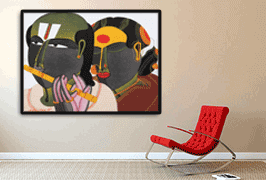Our Network

Thota Vaikuntum
Acrylic on canvas
Dimensions 12*16in
Year: 2015
THOTA VAIKUNTAM’S PAINTINGS CALM AND TRANQUIL ALL WHO SEE THEM. HE AVOIDS AN OBVIOUSLY DISTURBING FORM. BUT, HE HAS REPEATED THE PICTORIAL MOTIFS EXTENSIVELY.
HE AIMS TO HARMONIZE AN IMAGINATIVE IDEA WITH HIS TECHNICAL SKILLS. HIS PAINTINGS DEAL WITH THE THEME OF LOVE, WHICH IS ALWAYS INDIRECT AND VEILED.
HE DOES THIS SUCCESSFULLY BY USING SYMBOLS LIKE THE PARROT AND MIRROR. THE MIRROR REFLECTS THE NAYIKA’S MOOD AND THE PARROT HER GENTLENESS. THOTA VAIKUNTAM’S PARROT APPEARS AS AN ARDENT LISTENER TO THE LOVER’S WOES.
THE LINE OF VAIKUNTAM HAS A MAGICAL QUALITY SUGGESTING BOTH CONTOUR AND VOLUME. HE CONSCIOUSLY TURNS THE LINE OF FORCE, VOLUME, AND FEEL INTO DECORATION TO SUIT HIS PURPOSE. THE EROTICISM THUS APPEARS VERY SUBTLE AND MERELY SUGGESTIVE.
Like the folk painters, Thota Vaikuntam places the form without illusionistic depth. The fabric’s pattern and its repeated shapes reflect Vaikuntam’s urbanity. These elements show he could remodel any tradition to work out his style. We ignore the surroundings. We focus on the human tensions they create.
THESE SMALL PAINTINGS WITH LARGE FIGURES OCCUPY THE VIEWERS’ GAZE. THEY SEEM TRAPPED BY THEIR OWN DECORATED CLOTHES AND JEWELS. THEY SYMBOLIZE SOCIETAL RULES. VAIKUNTAM USES POWERFUL IMAGES OF WOMEN TO ILLUMINATE THE MEANING OF FEMININE BEAUTY.
Acrylic on canvas with Dimensions 12*16 in
| Dimensions | 12 × 16 in |
|---|---|
| Shipping | Unframed works ship in 7-10 business days. Framed works ship in 10-14 business days. |